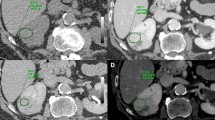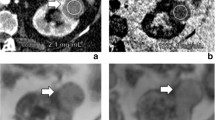Abstract
Purpose
Determine iodine content threshold discriminating papillary renal cell carcinomas (pRCC) from complex cysts (CCs) using rapid kV-switching dual-energy CT (rsDECT).
Materials and methods
IRB-approved retrospective study of 72 consecutive patients with pathologic diagnosis of renal cell carcinoma, who underwent rsDECT from 2011 to 2015. Controls included consecutive patients with CC during same period. Iodine content of each pRCC (n = 27) was measured on rsDECT workstation for arterial (n = 15) or nephrographic phase (n = 12), and compared to iodine content for clear cell renal cell carcinomas (ccRCC, n = 46) and complex cysts (n = 54). An optimal iodine content threshold was estimated using logistic regressions and Youden’s J based on maximum specificity and sensitivity.
Results
Iodine threshold of 1.28 mg/cc was optimal to discriminate between pRCCs and CCs for nephrographic phase (sens 1.0, spec 0.96, PPV 0.92, and NPV 1.0, AUC 0.997, acc 0.97, p < 0.0001). Iodine threshold of 1.22 mg/cc was the optimal cutoff value to discriminate between pRCCs and CCs in the arterial phase (sens 0.67, spec 0.97, PPV 0.91, NPV 0.85, AUC 0.76, and acc 0.84, p = 0.006). The optimal threshold to discriminate between ccRCCs and pRCCs was 1.85 mg/cc in the arterial phase (sens 0.87, spec 0.92, PPV 0.87, NPV 0.92, p < 0001) and 2.71 mg/cc in the nephrographic phase (sens 1.0, spec 1.0, PPV 1.0, NPV 1.0, p < 0.0001).
Conclusions
Quantitative iodine values on rsDECT discriminate between papillary RCC and complex cysts, and between papillary RCC and clear cell RCC, the former addressing an important clinical challenge particularly when an unenhanced series has not been performed. These rsDECT thresholds differ from values derived from dual-source DECT technology.





Similar content being viewed by others
References
Israel GM, Bosniak MA (2005) How I do it: evaluating renal masses. Radiology 236(2):441–450
Suh M, et al. (2003) Distinction of renal cell carcinomas from high-attenuation renal cysts at portal venous phase contrast-enhanced CT. Radiology 228(2):330–334
Feuerlein S, et al. (2012) Iodine quantification using dual-energy multidetector computed tomography imaging: phantom study assessing the impact of iterative reconstruction schemes and patient habitus on accuracy. Invest Radiol 47(11):656–661
Neville AM, et al. (2011) Detection of renal lesion enhancement with dual-energy multidetector CT. Radiology 259(1):173–183
Chandarana H, et al. (2011) Iodine quantification with dual-energy CT: phantom study and preliminary experience with renal masses. AJR Am J Roentgenol 196(6):W693–W700
Morgan DE (2014) Dual-energy CT of the abdomen. Abdom Imaging 39(1):108–134
Marin D, et al. (2014) State of the art: dual-energy CT of the abdomen. Radiology 271(2):327–342
Kaza RK, et al. (2011) Distinguishing enhancing from nonenhancing renal lesions with fast kilovoltage-switching dual-energy CT. AJR Am J Roentgenol 197(6):1375–1381
Mileto A, et al. (2014) Accuracy of contrast-enhanced dual-energy MDCT for the assessment of iodine uptake in renal lesions. AJR Am J Roentgenol 202(5):W466–W474
Ascenti G, et al. (2013) Distinguishing enhancing from nonenhancing renal masses with dual-source dual-energy CT: iodine quantification versus standard enhancement measurements. Eur Radiol 23(8):2288–2295
Mileto A, et al. (2015) Virtual monochromatic images from dual-energy multidetector CT: variance in CT numbers from the same lesion between single-source projection-based and dual-source image-based implementations. Radiology 279:269–277
Coleman BG, et al. (1984) Hyperdense renal masses: a computed tomographic dilemma. AJR Am J Roentgenol 143(2):291–294
Jonisch AI, et al. (2007) Can high-attenuation renal cysts be differentiated from renal cell carcinoma at unenhanced CT? Radiology 243(2):445–450
Birnbaum BA, et al. (2002) Renal cyst pseudoenhancement: evaluation with an anthropomorphic body CT phantom. Radiology 225(1):83–90
Silverman SG, et al. (2007) Hyperattenuating renal masses: etiologies, pathogenesis, and imaging evaluation. Radiographics 27(4):1131–1143
Ruopp MD, et al. (2008) Youden Index and optimal cut-point estimated from observations affected by a lower limit of detection. Biom J 50(3):419–430
Amin MB, et al. (1997) Papillary (chromophil) renal cell carcinoma: histomorphologic characteristics and evaluation of conventional pathologic prognostic parameters in 62 cases. Am J Surg Pathol 21(6):621–635
Delahunt B, Eble JN (1997) Papillary renal cell carcinoma: a clinicopathologic and immunohistochemical study of 105 tumors. Mod Pathol 10(6):537–544
Silverman SG, et al. (2008) Management of the incidental renal mass. Radiology 249(1):16–31
Kim JK, et al. (2002) Differentiation of subtypes of renal cell carcinoma on helical CT scans. AJR Am J Roentgenol 178(6):1499–1506
Teloken PE, et al. (2009) Prognostic impact of histological subtype on surgically treated localized renal cell carcinoma. J Urol 182(5):2132–2136
Leibovich BC, et al. (2010) Histological subtype is an independent predictor of outcome for patients with renal cell carcinoma. J Urol 183(4):1309–1315
Zhang J, et al. (2007) Solid renal cortical tumors: differentiation with CT. Radiology 244(2):494–504
Mileto A, et al. (2014) Iodine quantification to distinguish clear cell from papillary renal cell carcinoma at dual-energy multidetector CT: a multireader diagnostic performance study. Radiology 273(3):813–820
Author information
Authors and Affiliations
Corresponding author
Ethics declarations
Funding
No funding was received for this study.
Conflict of interest
Desiree E. Morgan has received research support from GE Healthcare and was a one-time consultant for educational materials for DECT. The other authors declare that they have no conflict of interest.
Ethical approval
All procedures performed in studies involving human participants were in accordance with the ethical standards of the institutional and/or national research committee and with the 1964 Helsinki declaration and its later amendments or comparable ethical standards.
Informed consent
Informed consent was obtained from all individual participants included in the study.
Rights and permissions
About this article
Cite this article
Zarzour, J.G., Milner, D., Valentin, R. et al. Quantitative iodine content threshold for discrimination of renal cell carcinomas using rapid kV-switching dual-energy CT. Abdom Radiol 42, 727–734 (2017). https://doi.org/10.1007/s00261-016-0967-5
Published:
Issue Date:
DOI: https://doi.org/10.1007/s00261-016-0967-5




